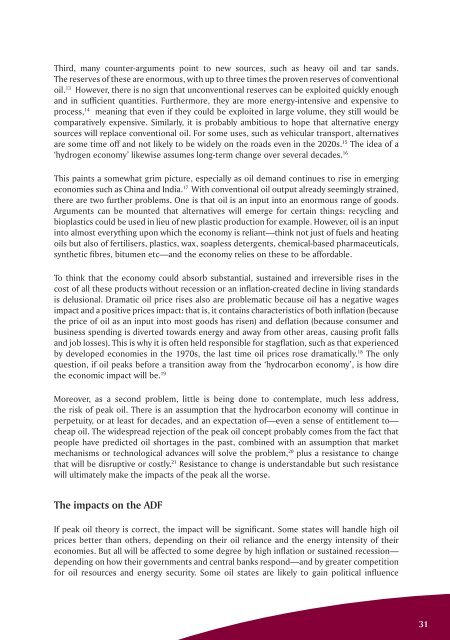ISSUE 180 : Nov/Dec - 2009 - Australian Defence Force Journal
ISSUE 180 : Nov/Dec - 2009 - Australian Defence Force Journal
ISSUE 180 : Nov/Dec - 2009 - Australian Defence Force Journal
- No tags were found...
Create successful ePaper yourself
Turn your PDF publications into a flip-book with our unique Google optimized e-Paper software.
Third, many counter-arguments point to new sources, such as heavy oil and tar sands.The reserves of these are enormous, with up to three times the proven reserves of conventionaloil. 13 However, there is no sign that unconventional reserves can be exploited quickly enoughand in sufficient quantities. Furthermore, they are more energy-intensive and expensive toprocess, 14 meaning that even if they could be exploited in large volume, they still would becomparatively expensive. Similarly, it is probably ambitious to hope that alternative energysources will replace conventional oil. For some uses, such as vehicular transport, alternativesare some time off and not likely to be widely on the roads even in the 2020s. 15 The idea of a‘hydrogen economy’ likewise assumes long-term change over several decades. 16This paints a somewhat grim picture, especially as oil demand continues to rise in emergingeconomies such as China and India. 17 With conventional oil output already seemingly strained,there are two further problems. One is that oil is an input into an enormous range of goods.Arguments can be mounted that alternatives will emerge for certain things: recycling andbioplastics could be used in lieu of new plastic production for example. However, oil is an inputinto almost everything upon which the economy is reliant—think not just of fuels and heatingoils but also of fertilisers, plastics, wax, soapless detergents, chemical-based pharmaceuticals,synthetic fibres, bitumen etc—and the economy relies on these to be affordable.To think that the economy could absorb substantial, sustained and irreversible rises in thecost of all these products without recession or an inflation-created decline in living standardsis delusional. Dramatic oil price rises also are problematic because oil has a negative wagesimpact and a positive prices impact: that is, it contains characteristics of both inflation (becausethe price of oil as an input into most goods has risen) and deflation (because consumer andbusiness spending is diverted towards energy and away from other areas, causing profit fallsand job losses). This is why it is often held responsible for stagflation, such as that experiencedby developed economies in the 1970s, the last time oil prices rose dramatically. 18 The onlyquestion, if oil peaks before a transition away from the ‘hydrocarbon economy’, is how direthe economic impact will be. 19Moreover, as a second problem, little is being done to contemplate, much less address,the risk of peak oil. There is an assumption that the hydrocarbon economy will continue inperpetuity, or at least for decades, and an expectation of—even a sense of entitlement to—cheap oil. The widespread rejection of the peak oil concept probably comes from the fact thatpeople have predicted oil shortages in the past, combined with an assumption that marketmechanisms or technological advances will solve the problem, 20 plus a resistance to changethat will be disruptive or costly. 21 Resistance to change is understandable but such resistancewill ultimately make the impacts of the peak all the worse.The impacts on the ADFIf peak oil theory is correct, the impact will be significant. Some states will handle high oilprices better than others, depending on their oil reliance and the energy intensity of theireconomies. But all will be affected to some degree by high inflation or sustained recession—depending on how their governments and central banks respond—and by greater competitionfor oil resources and energy security. Some oil states are likely to gain political influence31
















